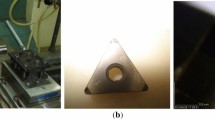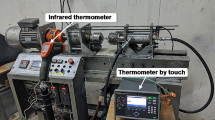This study is focused on the wear of the die cavity of the mechanical clinching tool used for joining microalloyed hot-dip galvanized advanced high-strength steel sheets H220PD+Z. Steel sheets were joined using round, single stroke clinching with rigid die with no flexible elements. The joint forming process takes place within the specially formed cavity of the die. Dies and punches for the mechanical clinching were made of tool steel (1.3343 grade) and subsequently covered by three types of PVD coatings: ZrN, CrN, and TiCN ones. The individual die wear was evaluated during the operation period, which means that 300 joints were produced by each die covered with the corresponding coating. The experimental data obtained were compared with the results of FEA numerical simulation, which substantiated the fact that the dominant part of wear is localized in the radius area surrounding the die cavity.








Similar content being viewed by others
References
A. Breda, S. Coppieters, and D. Debruyne, “Equivalent modeling strategy for a clinched joint using simple calibration method,” Thin Wall. Struct., 113, 1–12 (2017).
M. Eshtayeh, M. Hrairi, and A. K. M. Mohiuddin, “Clinching process for joining dissimilar materials: state of the art,” Int. J. Adv. Manuf. Tech., 82, 179–195 (2016).
J. Mucha, “The analysis of lock forming mechanism in the clinching joint,” Mater. Design, 32, 4943–4954 (2011).
F. Lambiase and A. Di Ilio, “Finite element analysis of material flow in mechanical clinching with extensible dies,” J. Mater. Eng. Perform., 22, 1629–1636 (2013).
K. Mori, N. Bay, L. Fratini, et al., “Joining by plastic deformation,” CIRP Ann. - Manuf. Techn., 62, 673–694 (2013).
T. Gerstmann and B. Awiszus, “Recent development in flat-clinching,” Comp. Mater. Sci., 81, 39–44 (2014).
S. Härtel, M. Graf, T. Gerstmann, and B. Awiszus, “Heat generation during mechanical joining processes – by the example of flat-clinching,” Procedia Engineer., 184, 251–265 (2017).
Y. Zhang, H. Shan, Y. Li, et al., “Joining aluminum alloy 5052 via novel hybrid resistance spot clinching process,” Mater. Design, 118, 36–43 (2017).
Y. Futamura and M. Miura, “Characteristics of 780 MPa and 980 MPa grade hot-dip galvannealed steel sheets,” Kobelco Technol. Rev., No. 28, 3–7 (2008).
Y. Abe, S. Nihsino, K. Mori, and T. Saito, “Improvement of joinability in mechanical clinching of ultra-high strength steel sheets using counter pressure with ring rubber,” Procedia Engineer., 81, 2056–2061 (2014).
J. P. Varis, “The suitability of round clinching tools for high strength structural steel,” Thin Wall. Struct., 40, 225–238 (2002).
Y. Abe, T. Kato, and K. Mori, “Mechanical clinching of ultra-high strength steel sheets,” in: Proc. of 14th Int. Conf. on Metal Forming (Sept. 16–19, 2012, Krakow, Poland), Wiley-VCH Verlag GmbH&Co KGaA, Weinheim (2012), pp. 615–618.
J. Varis, “Ensuring the integrity in clinching process,” J. Mater. Process. Tech., 174, 277–285 (2006).
S. Zhang, Thin Films and Coatings – Toughening and Toughness Characterization, CRC Press, Taylor & Francis Group, New York (2016).
M. Wieland and M. Merklein, “Wear behavior of uncoated and coated tools under complex loading conditions,” Tribology in Industry, 34, 11–17 (2012).
J. Varis, “Economics of clinched joint compared to riveted joint and example of applying calculations to a volume product,” J. Mater. Process. Tech., 172, 130–138 (2006).
O. Hahn, L. Budde, “Analyse und systematische einteilung umformtechnischer fugeverfahren ohne hilfsfugeteil,” Blech Rohre Profile, 37, 29–32 (1990).
J. Mucha, L. Kaščák, and E. Spišák, “The experimental analysis of forming an strength of clinch riveting sheet metal joint made of different materials,” Adv. Mech. Eng., 1, 1–11 (2013).
D. A. Skobir, “High-strength low-alloy steels,” Mater. Technol., 45, 295–301 (2011).
J. Slota, Computational Modeling of Sheet Metal Pressure [in Slovak], Technical University of Košice, Košice, Slovakia (2017).
Author information
Authors and Affiliations
Corresponding author
Additional information
Translated from Problemy Prochnosti, No. 5, pp. 140 – 153, September – October, 2017.
Rights and permissions
About this article
Cite this article
Kaščák, L., Mucha, J., Spišák, E. et al. Wear Study of Mechanical Clinching Dies During Joining of Advanced High-Strength Steel Sheets. Strength Mater 49, 726–737 (2017). https://doi.org/10.1007/s11223-017-9918-9
Received:
Published:
Issue Date:
DOI: https://doi.org/10.1007/s11223-017-9918-9




